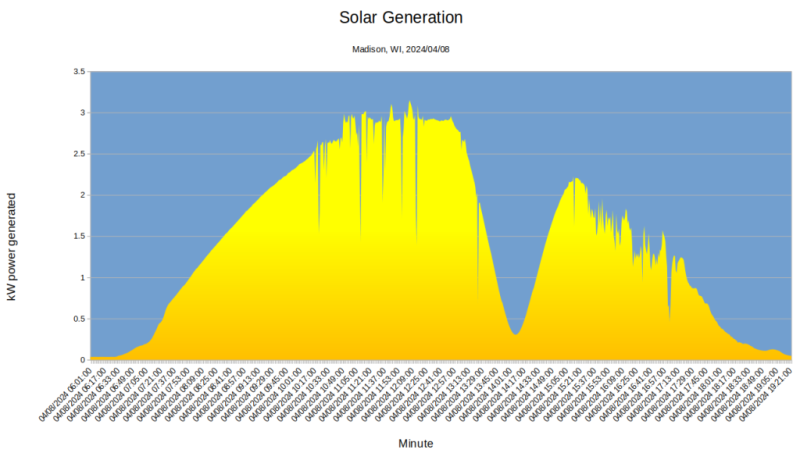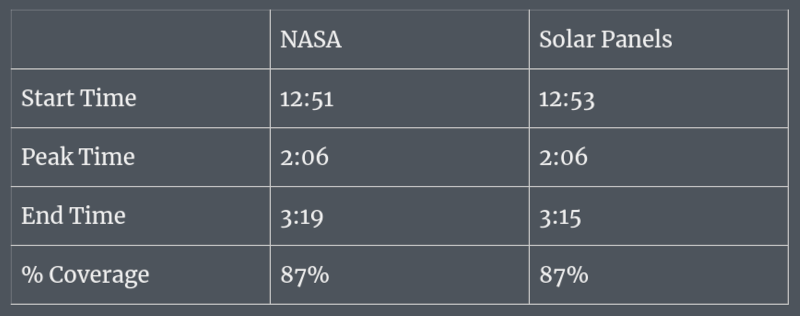If you were lucky enough to be near the path of totality, and didn’t have your view obscured by clouds, yesterday’s eclipse provided some very memorable views. But you know what’s even better than making memories? Having cold hard data to back it up.
 Hackaday contributor [Bob Baddeley] was in Madison, Wisconsin for the big event, which NASA’s Eclipse Explorer website predicted would see about 87% coverage. Watching the eclipse through the appropriate gear at the local hackerspace was fun, but the real nerding out happened when he got home and could pull the data from his solar system.
Hackaday contributor [Bob Baddeley] was in Madison, Wisconsin for the big event, which NASA’s Eclipse Explorer website predicted would see about 87% coverage. Watching the eclipse through the appropriate gear at the local hackerspace was fun, but the real nerding out happened when he got home and could pull the data from his solar system.
A graph of the system’s generated power shows a very clear dip during the duration of the eclipse, which let him determine exactly when the occlusion started, peaked, and ended.
What’s more, by comparing the output of the panels at their lowest with the pre-eclipse peak, [Bob] was able to calculate that the light falling on them dropped by roughly 87 to 90% — right where NASA pegged it. Similarly, the timing of the eclipse as experienced by his solar system lined up within a few minutes of what the website predicted.
That the world’s leading space agency was able to properly model one of the biggest celestial events in recent memory is perhaps not overly surprising. That’s part of what we’re paying them for, honestly. But it’s always good to run a second set of eyes over the numbers.


















We had overcast skies.
And today we have clear skies, don’t we get another eclipse?
“Eclipse has trouble with cloud” could also fit into the This Week In Security column :o)
Old Man Yells at Cloud?
Maybe laser them out next time.
So did I, but a hole opened up in the clouds at just the right time. Score
It was a big worry with rain the previous night, and a chance rest of the week. There were still clouds going through during the event, but when totality came it was clear. The temperature drop, and the bright white ring of fire was something else.
I got lucky, the clouds cleared up just in time in the afternoon. Since I lived right in the path of totality, I could just stay home for the show.
Hazy cloud can actually be advantageous, because you don’t go blind.
The dangerous part of the spectrum, the UV rays, DO penetrate the clouds, as can be arrested to by the amount of people who get severe sunburns on overcast/cloudy days.
“his solar system” <– had to laugh, wondering which solar system he hails from.
This one. I just don’t charge you rent. :D
Good one, and thanks for showing me that same courtesy. 😁👍
Any planetary system orbiting a star named “Sol” of course.
Funny, did something similar, though less sciency: https://www.reddit.com/r/raspberrypipico/comments/1bz7i1f/follow_up_raspberry_pi_pico_captures_the_passage/?utm_source=share&utm_medium=web3x&utm_name=web3xcss&utm_term=1&utm_content=share_button
Reminds me of the thermometer logging data from my greenhouse – turns out the graph is a perfect rendition of the horizon south of the greenhouse. You can definitely make out a tree and a neighbor’s roof line.
Single pixel camera, in effect.
Drove south 2 hours from Branson, Mo. to Clinton, Ark. a small town on the centerline that had no crowds and clear skies. Totality was long and awesome. Waiting for my pics to be ready at the photo lab. Yep…I shot film on an old school Minolta XGM…oops gotta go flip my POCO album over on the turntable…
If only I wasn’t down under during this event, us Aussies will see our next eclipse in 2028, my area with 84% coverage.
drove up the NB coast to Kouchibouguac National Park
for the total event
there is no such thing as a partial eclipse
seeing the suns corona,naked eye with a huge solar flare
on the bottom left
3.5 hr drive each way,huge,HUGE,traffic jams in the middle of nowhere
awsome,worth it many times over
Was it a flare or not quite totality?
No reason to assume it wasn’t a flare; many people saw flares and the better pictures make it clear that’s what they are.
Turns out it may have been correctly called a “prominence” rather than a flare, as it was still connected and not going anywhere.
Darn straight! Brutal ride but eminently worth it! Apparently experiencing totality with your identical twin will not trigger the End Times! My 30+ year old Meade DS-2090 alt-az – made from parts that never left the factory together – tracked better than my brother’s modern iOptron! (Snicker) shuffle played “Invisible Sun” on loonnnngg ride back. Got great images !
Ditto on experience and ride!
Also experiencing it with my identical twin did not trigger Ragnarok
Our apologies to those of you who were hoping for that to occur.